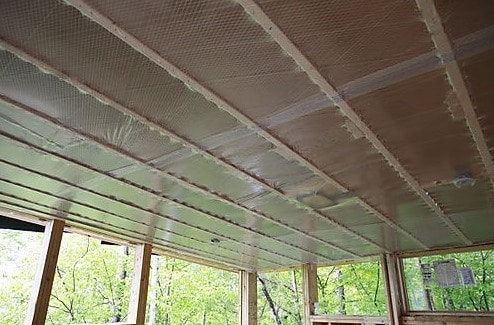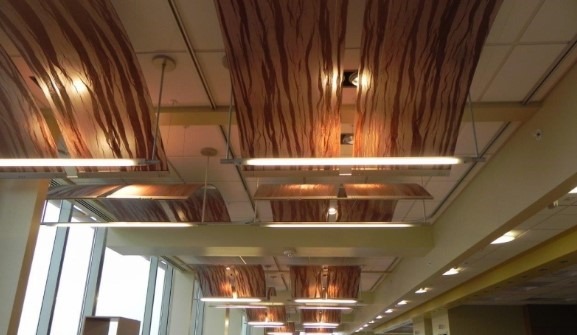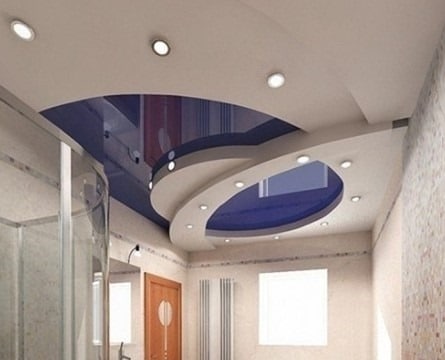Ceiling types used in Building Construction and their Applications
Various types of ceiling are used in building construction. Applications, aesthetics, advantages and disadvantages of these types of ceilings are discussed in this article.
The ceiling of a building form one of the most important structural elements it terms of functionality as well as creativity which in turn bring good aesthetics to the building interior. This document would help you understand ceilings that in turn would help you understand the most suitable options while undertaking either repair or renovation work of our building interior.
The ceiling gains a definition, ” A part of a building which encloses and is exposed overhead in a room, protected shaft or circulation space.”
It helps us to create an enclosure and separation between spaces. They provide perfect lighting in the room by controlling diffusion of light. It also controls the sound around a room by making the room sound proof. It, therefore, stops the passage of sound between the rooms.
Now ceiling also possesses fire resistant properties that would facilitate accommodation of building services such as vents, lighting, sprinkler heads etc. If we have any other services like ducts, pipes, and wiring that are messed up together, that they don’t give a good appearance, it can be concealed by means of ceiling covering.
Table of Contents [show]
Types of Ceiling used in Building Construction
Now we will discuss types of ceiling. This would give an idea to decide what would work best for a new building construction as you have many options for the same. The types are:
- Exposed Ceilings
- Tightly attached ceiling
- Interstitial ceilings
- Acoustical Ceilings
- Radiant Chilled Ceilings
- Convective Chilled Ceilings
- Suspended Ceilings
1. Exposed Ceilings
As shown in figure-1, this kind of ceiling arrangement would completely expose the structural and mechanical components of the building thus omitting a concept of finished ceiling. This arrangement lacks a discomfort in aesthetics but gains many advantages like the economy, easy maintenance due to ease of access. This also enables the thermal mass of the building to be exposed.
Further, the above-mentioned exposed thermal mass can be exploited by installing heating or cooling elements like chilled beams that will be discussed in the following discussions.

Fig.1. Exposed ceiling example in the interior of an office room
The disadvantage mentioned before of looks can vanish if we design , install roof structures and floor structures properly , leaving it exposed in the space below by means of timber beams or concrete slabs or space trusses. It’s true that the mechanical element arrangement at ceiling level in a well systematic manner would create an attractive aesthetic effect.
2. Tightly Attached Ceiling

Fig.2.Tightly Attached Ceiling
3. Interstitial ceilings
An interstitial space is defined as an intermediate space kept between regular-use floors. It is commonly located in hospitals and laboratory-type buildings to allow space for the mechanical systems of the building.
Laboratory and hospital rooms are easily rearranged throughout their lifecycles and therefore reduce lifecycle cost. This ensures more flexibility in the interiors of the building rooms.
They include a walkway for access with a low height. Mainly employed in buildings that have the following units:
- Electrical and communications wiring
- Air-conditioning ducts
- Oxygen
- Chilled water
- Vacuum pipe work
- Chemical sewer pipe work
- Water and waste pipework
- Fuel gas lines
- Compressed air lines

Fig.3. A picture depicting interstitial space arrangement

Fig.4. A Real Example of Interstitial Ceiling Space Arrangement
The ducts and pipe work occupy some space, which often requires continual maintenance and are subject to frequent change. The main advantage of interstitial ceilings is that they allow for maintenance and updating work, without interruption of activities in the spaces above and below.
4. Acoustical Ceilings
This ceiling is mainly implemented to control sound reverberation in a hall where there is the possibility of large sound propagation to make the hearing comfort zone. The acoustic ceiling material is made from fibrous materials that would absorb sound energy unlike other materials like plaster or gypsum ceilings.
These materials do not reduce transmission of sound between the spaces. They result in a reduction in the amount of sound that reflects into space. Hence it can be used to bring the modify acoustic character of space.

Fig.5. A Real Example of Acoustical Ceiling Arrangement
The performance of the ceiling material in terms of sound absorption can be expressed in terms of noise reduction coefficient (NRC). An NRC of 0.85 means that a ceiling material absorbs 85% o the sound that reaches it, and an almost 15% reflects back to the room.
Most of the acoustical ceilings NRC range from 0.5 to 0.9. This value is found to be 0.10 for plaster and gypsum ceiling board materials.
5. Radiant Chilled Ceilings
Radiant chilled ceilings include a network of chilled water coils in ceiling panels with insulation above. For some systems, pipework may be incorporated into plaster board. But this is found less efficient as plaster is an insulator.
The ceiling surface then cools the occupied space by both radiation and convection, providing temperatures throughout the space and avoids draught. The space requirement for chilled ceilings is found to be less, which may be installed with a depth of just 100mm. For some, a small-bore cooling coils can be embedded in plaster ceiling.
6. Convective Chilled Ceilings
These types of ceilings are a deviation from radiant chilled ceilings, in which the network of chilled water pipes incorporates fins, increasing the proportion of cooling that is provided by convection.
7. Suspended Ceilings
These are secondary ceilings suspended from the structure above (typically a floor or roof slab), creating a void between the underside of the slab and the top of the suspended ceiling. This void can provide a useful space for the sprinklers, distribution of heating, ventilation, and air conditioning (HVAC) services and plumbing and wiring services.
This also provides a display place for the installation of speakers, and smoke detectors, motion detectors, light fittings, wireless, antenna, CCTV, fire and so on. It provides an air ‘plenum’, in which the void itself forms a pressurized ‘duct’ to supply air to or extract it from the taken space below.

Fig.7. Suspended Ceilings
This is the one that contributes to fire-resistance in commercial and residential construction. In the case of a dropped ceiling (the other name of suspended ceiling), the rating is achieved by the entire system, which includes:
- · the structure above, from which the ceilings is suspended. This can be a concrete floor or a timber floor
- the suspension mechanism
- the lowest membrane or dropped ceiling.
Between the structure that the dropped ceiling is suspended from and the dropped membrane, there is frequently some room for mechanical and electrical piping, wiring and ducting to be incorporated.
An independent ceiling can be constructed which has a separate fire-resistance. Such systems must be checked without the benefit of being suspended from a slab above so that it can hold itself up. This type of ceiling would be installed to protect items above from fire.
Comments
Marble Cleaning Services Dubai
Before picking on Construction Company’s oxford, you must first determine the type of project you want to build. We've outlined some tips for selecting the best construction company for house renovation in Oxford.
The best construction companies in Oxfordshire that can give you with a price for the type of home improvement job you're considering. A reputable handyman oxford provider also has responsibility insurance to cover personnel who are hurt on the job.